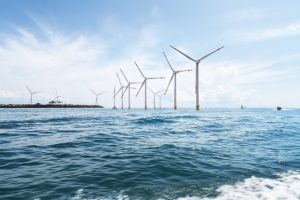
Vietnam, maximising the wind revolution in energy sector
With a recent rise of renewables in Vietnam triggered by the growing demand for electricity and conducive policies, solar power projects are outpacing wind power ones. How can wind development catch up with the solar boom in country?
The development in both wind and solar power demonstrates Vietnam’s efforts to meet the targets set in the Revised Power Development Master Plan VII to produce 10.7 per cent of its electricity from renewable sources by 2030, thanks to a big push for incentives.
As an early bird in the wind power sector, Bui Van Thinh, chairman and CEO of Thuan Binh Wind Power JSC, brought Phase 1 of the Phu Lac wind plant in the south-central province of Binh Thuan into commercial operation and connected it to the national grid in 2016. He said the company is going to continue to develop another wind power project in the neighbouring province of Ninh Thuan this year.
However, Thinh admitted that investing in solar power offered more benefits than wind, because of the regulated feed-in tariff (FiT) of 9.35 cents per kWh for solar power.
The company also plans to develop a 150 megawatts (MW) solar power plant on the area the company had initially intended to use to expand the Phu Lac wind power plant. The construction of the solar power project will be implemented in three phases. The company is currently conducting the pre-feasibility study, an environmental impact assessment, and capital arrangement for the first phase of the project.
Positive movements
At last week’s Vietnam Energy Summit 2019 in Hanoi, Nguyen Quang Minh, deputy director of the Power System Department at the Electricity Regulatory Authority (ERA), said, “In Vietnam, there are seven wind farms in operation with total installed capacity of 270MW. Around 4,000MW of wind energy has been approved in the master plan. After Decision 39, another 7,000MW is being proposed for approval in the plan.”
The government’s Decision No.39/2018/QD-TTg dated September 2018 on the revision of the wind FiT replacing the government’s Decision No.37/2011/QD-TTg on the support mechanism for the development of wind power projects is seen as a positive move by the Vietnamese government to promote wind and renewable energy.
Vu Chi Mai, senior project officer for a venture under the GIZ Energy Support Programme, told VIR right after the decision was released, “It is a positive signal for not only the Vietnamese energy sector, which sees constantly rising demand, but also for the Vietnamese people. With the new FiT, wind power can contribute more to national energy security and indirectly support the country’s economic development and the mitigation of climate change impacts in a more efficient manner.”
The possibility for wind development to develop as successfully as the solar boom in Vietnam was a hot topic raised at the energy summit, which was partaken in by over 300 professional participants.
According to the ERA, the total designed capacity of solar power projects approved to be added to the Power Development Plan VII (PDP 7) as well as projects awaiting to be added are quite large, far exceeding the PDP 7.
Many agreed that Vietnam has huge potential wind power energy, with the market’s developments reflecting the policy. Vietnam’s renewable energy sector is no exception, especially in the context of wind energy prices continuing to fall due to technological advancements and cost reductions.
The Mekong Delta province of Tra Vinh’s People’s Committee has recently given the go-ahead to Singapore-based Janakuasa Pte., Ltd., and Ecotech Vietnam to build the Hiep Thanh Wind Power Plant with total investment of VND3.37 trillion ($146.5 million). The 2,700 hectare plant has a designed capacity of 78MW from 18-19 turbines.
Earlier, the province also licensed South Korea’s Unison eTech Co., Ltd., and Ho Chi Minh City-based Asia Energy Petroleum Corporation to develop the first phase of the Duyen Hai wind power project, which will see an investment of VND2.8 trillion ($121.7 million) in its first phase, with a designed capacity of 48.3MW from 21 turbines. Once operational in December 2019, the project is expected to generate over 135,200MWh per year.
Foreign investors have also planned to pour cash into wind power projects in other coastal provinces of Vietnam where there is untapped huge potential for wind power development. Siemens Gamesa Renewable Energy (SGRE) announced that it will install and commission the Dam Nai wind farm with 39MW in Ninh Thuan.
SGRE said that it expects significant growth in Vietnam in the coming years as the country begins to utilise some of the best wind resources in Southeast Asia, the target being to install one gigawatt (GW) by 2020.
South Korea’s Doosan Heavy Industries and Construction Company in March 2019 also announced a plan to shake hands with Electricity of Vietnam (EVN) to develop an offshore wind farm project, in which Doosan will supply wind power equipment, including energy storage systems in the form of engineering, procurement, and construction for a 3MW wind farm.
Meanwhile, Thailand’s largest solar energy company Superblock Pcl., also planned to invest $1.76 billion to install 700MW of wind farms in Vietnam. The first phase of the investment will cost about $650 million and consist of three near-shore farms with 142MW of capacity in Bac Lieu, 98MW in Soc Trang, and 100MW in Ca Mau province, all in southern Vietnam.
The second phase of 360MW will also be carried out in these three provinces and construction will begin when the first phase concludes. Chairman of Superblock, Jormsup Lochaya, expects the projects to be operational by 2020.
Tackling grid constraints
Due to Vietnam’s growing need for energy and excellent wind power resources, many developers have considered the market for quite some time because two of the biggest bottlenecks include grid constraints and power purchase agreements (PPAs), with Vietnam not being fully prepared for upcoming demands. It takes three years, on average, to build a power grid project, while a wind or solar power one needs shorter time to be put in place. As a result, electric grid development cannot catch up with the proliferation of solar and wind power projects.
“Smart grid and auction design can help the market respond,” Caroline Chua, lead analyst for renewables Bloomberg NEF suggested at the conference last week.
Meanwhile Patrick Architta, business development director at K2 Management, which recently opened an office in Vietnam, said that even though PPAs are signed with EVN, the government does not act as a guarantor to EVN in case of it defaulting on payment.
“This risk often proves unacceptable to international banks. However, private investors and Vietnamese banks are much more capable of taking such aggressive risks,” Architta suggested.
Vu Chi Mai from the GIZ Energy Support Programme said that in the long run, to achieve governmental goals on renewable energy development, adjustments to PPAs should be considered to meet the requirements of international financial institutions. This will have a positive impact on the financing of wind power ventures. Investors and bankers have asked that PPAs must be clear that it is a “take or pay” agreement. Under the current template, EVN will be released from the obligation to purchase the power in specific circumstances.
On a positive note, Architta said, “As soon as the PPA becomes bankable we will see an acceleration of the installed capacity.”
Olivier Duguet, chief executive officer of Singaporean firm The Blue Circle, which develops Dam Nai wind energy projects in Ninh Thuan, told VIR that as Vietnamese banks are not familiar with long-term financing, the maximum tenure for debt financing projects is around 10 years, compared to a 20-year PPA the undertaking would sign with EVN. In Europe, typically debt financing would be 17 to 18 years if the PPA is signed for 20 years. The shorter the tenure, the higher the pressure on short-term project cash flow to cover debt service, and the higher the chances to default if a poor wind year is coming.
The best way to ease the pressure on project cash flow and to lower the long-term risk of wind power financing in Vietnam would be to allow the indexation of the PPA price on inflation. As the operating costs of wind projects and debt financing available are mostly at floating rates, balancing the potential rise in salaries and interest rates with an indexation on the consumer price index would cover this risk for the debt provider and ease long-term financing. Introducing indexation of the FiT would not change the price today.
Some suggest that wind power projects in Vietnam are entitled to several investment incentives under the Law on Investment and other relevant policies, such as relaxing regulations on corporate income tax, import duty, investment capital, and government funding. The abundance of laws, bylaws, and related prerequisites further complicate legal guidance. Investment into the wind power sector is now precluded by a complicated legal framework and regulations scattered in different places. Thus, a comprehensive guideline is desirable.
Source: https://english.vietnamnet.vn/fms/business/220785/maximising-the-wind-revolution-in-energy-sector.html#ui=mobile



